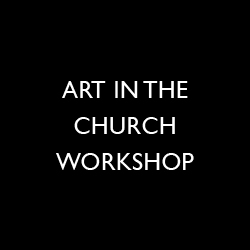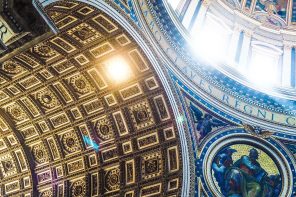“It is space on earth that is made holy, not because of the place itself but because of what God does for humans in that place.” James F. White [1]
Often times, when followers of Christ gather together for the purpose of worship, there is little thought put into the space that they gather in. In some denominations, leaders of the community meeting in a particular space tend to think of the utilitarian aspects of the space – does it cover all of our basic needs for a meeting place? While this might be the precedent in some churches, I suggest that it is essential that gathered communities intentionally think about the space in which they will worship. This begins with viewing the space, whatever that space may be, as a gift for the community – as a place “set-aside”, a “sacred” space – rather than an ordinary, utilitarian space. This practice alters our experience of time and space while art and beauty in the church finds a natural fit, evidenced by my concluding example.
When considering the worship space with intention, it becomes possible to step out of what is known as ordinary time and step into Kairos time where God longs to meet us. The intention in this instance can be described as a deliberate undertaking to make a space conducive to the act of worship. It is God who makes a space sacred, but as the Body of Christ we are called to be his hands and feet. And this work should be viewed as an act of worship and service to God and the church.
Kairos time can be defined as the appointed time in the purpose of God, or the time in which God acts. It lives outside the bounds of Chronos, the time we know via our clocks, watches, and smartphones. Kairos time can best be illustrated by the moments we experience where we feel Chronos time, the second hand ticking away in the background, has become strangely silent or forgotten. Chronos time has stood still, and we are dipping our toes into the stream of Kairos where time passes effortlessly and unmeasured.
While time becomes elastic, so does the space one is in. This is sometimes referred to as the “thinning” of the space, where the “divide” between heaven and earth fades and we feel a holy presence. When consideration of the space we gather in for worship is done with intention and purpose, it can aid in the stepping into Kairos time and the thinning of the space. This is in keeping with a long tradition of the use of space in worship dating back to the elaborate and detailed instructions given to the Israelites for building the Temple in Jerusalem.[2] Jesus also had holy space in mind when he said:
The hour is coming when you will worship the Father neither on this mountain nor in Jerusalem… But the hour is coming, and is now here, when the true worshippers will worship the Father in spirit and truth (John 4:21, 23a)
How does this apply in practice to a worship space and service? I will conclude with an experience I participated in that illustrates how intention and purpose coupled with an attuned-ness to God’s leading can facilitate a transformation of the space. During our most recent Holy Week, I attended a Tenebrae service at a church that had never done one. What was remarkable was how the members of the community took a rather dull, ordinary space and made it crucial to the ethos of the worship.
We entered in through a lobby I knew to be dreary. At the service, it had been lit with candlelight while Stations of the Cross marked our path in the sanctuary. Each station slowed down one’s journey into the space because they “got in our way”. I found myself walking alongside Jesus as he carried his cross through the streets of Jerusalem and by the time I reached the dimly lit sanctuary, I was at the foot of the Cross. Prayer stations dotted the room with our attention focused on the cross and table below it. In that space, I was very aware of my surroundings and the stepping out of ordinary time. I found myself open to hear God speak to me and worship Him – I was aware that this space I had walked through numerous times without a second thought was holy other. That night, God graced us with his presence and blessed the work of those who, as an act of worship, purposefully transformed an “ordinary” space into a sacred space.
*Portions of this article were taken from a chapter I wrote, A Holy Space, for the book Praying the Hours in Ordinary Life by Lauralee Farrer and Clay Schmit.
Nate Risdon is the Associate Director of Communications and Program Development for the Brehm Center for Worship, Theology, and the Arts at Fuller Theological Seminary. He has had a long time fascination with popular music and its influence on society and has just begun to think of these implications on theology and the church.
[1] White, James F., Introduction to Christian Worship (Abingdon Press, 2000), 81.[2] Such as in 1 Kings and 1 Chronicles.






Interesting post Nate!
It is always a pleasure to read about this interesting topic as it is one of the most interesting ones in the studies of Sciences of Religions yet one of the most misunderstood by “cartesian minded” people.
The worship transforms, reveals, the spaces (chronological and physical) in which we exist into something more, something else. Into a transformed topos (cfr. Henry Corbin) in which the “inside space”, the space of meaning, coincides with the outside expressions. Into a transformed time, an illud tempus (cfr. Mircea Eliade), that doesn’t flow in an empty motion but that lingers, that exists in dialogical interaction with what happens in it.
As holy is a structural element of conscience (and reality), not a mere phase of it, worship reveal an essential dimension of place and moment to the human life: the space of relationship.
Than you for sharing,
Leticia
Hi Leticia,
Thank you for your comment. I must admit that I myself struggle with the Cartesian dualism a lot. However, I am consistently reminded of how God works outside the normal circles or constraints, such as Chronos time (though I tend to default back to those constraints for various reasons). I do like how you put it: “worship reveals an essential dimension of place and moment to the human life: the space of relationship.” The desire to be in relationship with God is consistent drive fundamental to who we are as Imago Dei.
Hi Nate,
More than the dualism, I had in mind the Cartesian conception of space, the math based, mechanical, res extensa. Of course it implies a dualism, but I don’t think that dualism necessarily hurts the epiphanic capacity of time and space; dualistic cultures like the classic Greeks or the Platonic/Plotinian Middle Ages, being dualistic, had a very strong sense of time and space as “translucent” when it came to the Divinity.
Thank you!
Nate, thanks for this great reflection on the importance of attending carefully to the spaces that we use and construct for our worship of God. I find this idea of a sacred space as a thin space very interesting, and I have a couple of questions about it.
First, you write that only God can make a space sacred, but that we can also aid in the thinning of space by shaping the spaces in which we worship. Does this mean that humans have some control over where and when some spaces are ‘thinned’?
Second, do you think that there are certain sorts of spaces that are more or less conducive to the thinning of space? For example, is a medieval Cathedral more likely to usher us into a thinner space than, say, a high school gymnasium? What about the austerity of church space often associated with the Dutch reformed tradition in which emptiness is emphasized in order to focus one on the Word? It is interesting that you chose to quote John 4:21, 23a because I have heard these verses used to justify a very austere worship space. It is sometimes assumed (wrongly in my view) that worshipping in ‘spirit and truth’ means worshipping in the absence of materiality and sensuality, which are seen as distractions to the worshipper.
Thanks, again, for sharing your thoughts and experience!
Hi Jim,
Thank you so much for the comment on my post.
Regarding your first point, on one level humans do have control over a space. Worship is an activity, not something that we idly observe. So I would argue that there needs to be some intentional thought about the space you choose to worship in whether in community or even by yourself. In this way, God allows us to participate in the thinning of the space. Perhaps facilitate is a better word for this interaction. However, no amount of candles, gilded ornaments, frescoes, will thin a place without God in the equation. I do think God will honor our intention when it is rightly directed toward him.
On your second point, I absolutely agree – I would argue that austere worship space leads to as many distractions as one that more appropriate engages us sensually. Austerity of space doesn’t necessarily lead to focused worship. Though one could argue that there is a time or place for it. Active engagement with the elements of worship in all of its sensual expressions engage humans more fully. Jesus’ words in John were spoken in an active place surrounded where hundreds of people gathered daily for water. Lots going on and a lot to see and observe. I believe Jesus was expressing that the divide between the sacred and the profane specifically about space in which we can worship God was unjustified and false.